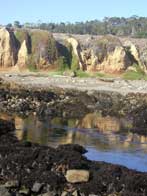What is a tide pool (or Rocky Intertidal Habitat)?
 Tide pools, or rocky intertidal habitats, are located along the open coast where the sea meets the land. These species-rich habitats are regularly exposed to the air as the tide goes out (low tide) and then are covered by water again as the tide comes in (high tide). Any portion of the coastline that is exposed to air during low tides is considered to be "intertidal." The magnitude and the timing of low tides vary greatly over the day and over the year. In California, there are two low tides and two high tides per day with one low tide being lower than the other. Depending on the magnitude of tide, tide pool habitats may be exposed to air for 4-6 hours before the high tide returns. Although the term "tide pool" will be used interchangeably here, the true definition of tide pool refers to portions of the intertidal zone where water is trapped in depressions in the rock as the tide recedes, creating pools of water.
Tide pools, or rocky intertidal habitats, are located along the open coast where the sea meets the land. These species-rich habitats are regularly exposed to the air as the tide goes out (low tide) and then are covered by water again as the tide comes in (high tide). Any portion of the coastline that is exposed to air during low tides is considered to be "intertidal." The magnitude and the timing of low tides vary greatly over the day and over the year. In California, there are two low tides and two high tides per day with one low tide being lower than the other. Depending on the magnitude of tide, tide pool habitats may be exposed to air for 4-6 hours before the high tide returns. Although the term "tide pool" will be used interchangeably here, the true definition of tide pool refers to portions of the intertidal zone where water is trapped in depressions in the rock as the tide recedes, creating pools of water.
Tide pool habitats can be divided into four major zones, the splash zone, high zone, middle zone, and low zone; the splash zone tends to be only rarely covered by water while the low zone is only exposed to air during extreme low tides. Rocky intertidal habitats are considered to be harsh ecosystems as plants and animals living on the rocks are forced to deal with:
- drying out (desiccation) when exposed to the air and sun,
- high fluctuations in temperature, salt concentrations, and oxygen content as the tide moves in and out, and
- high wave force as waves crash onto rocky shores.
Plants and animals in tide pool ecosystems are primarily marine species that are well adapted to these harsh conditions. For example, bivalve mussels attach to rocks using a strong cement-like substance, as well as being "streamline" shaped to deflect water, in order to not be knocked off the rocks by crashing waves. During low tides, mussels close up in order to keep water in their shells so that they do not dry out or have to deal with changes in salt concentrations. In many cases, the ability of plant or animal to deal with the harshness of the ecosystem will determine in which of the four zones they tend to live in.

